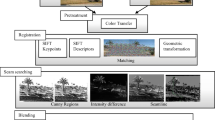Abstract
In the traditional manifold mosaic, a single center strip is clipped out from each source image to create a large image. Therefore the displacement between neighboring views should be very small in order to fulfill effective strips cutting. In this paper, a method is proposed to create a manifold mosaic by images with relative large displacement by means of cutting out multiple strips in the overlap area according to the homography between images. These strips are then warped together to create a smooth mosaic. An improved RANSAC algorithm is also presented in order to improve the precision of homography calculation. Experimental results demonstrate the efficiency of the method.
Similar content being viewed by others
References
Szeliski R, Shum H Y. Creating full view panorama image mosaics and environment map. In Proc. the 24th Annual Conf. Computer Graphics and Interactive Techniques, August 1997, Los Angeles, United States, pp.251–258.
Szeliski R. Video mosaics for virtual environments. IEEE Computer Graphics and Applications, March 1996, 16(2): 22–30.
Fang X, Pan Z, Xu D. An improved algorithm for image mosaic. Journal of Computer-Aided Design and Computer Graphics, November 2003, 15(11): 1362–1365. (in Chinese)
Brown M, Lowe D. Recognising panorama. In Proc. the 9th Int. Conf. Computer Vision, October 2003, Nice, France, pp.1218–1225.
Torr P, Zisserman A. Feature based methods for structure and motion estimation. In Proc. the Int. Workshop on Vision Algorithms: Theory and Practice, September 1999, London, United Kingdom: Springer-Verlag, pp.298–373.
Hartley R, Zisserman A. Multiple View Geometry in Computer Vision. Cambridge, United Kingdom: Cambridge University Press, June 2004.
Cho S H, Chung Y K, Lee J Y. Automatic image mosaic system using image feature detection and Taylor series. In Proc. the 7th Int. Conf. Digital Image Computing: Techniques and Applications, Dec. 2003, Sydney, Australia, pp.549–556.
Peleg S, Herman J. Panoramic mosaics by manifold projection. In Proc. IEEE Computer Society Conference on Computer Vision and Pattern Recognition, June 1997, San Juan, Puerto Rico, pp.338–343.
Duplaquet M-L. Building large image mosaics with invisible seam-lines. In Proc. SPIE AeroSence, April 1998, Orlando, United States, Vol.3387, pp.369–377.
Rousso B, Peleg S, Finci H. Mosaicing with generalized strips. In DARPA Image Understanding Workshop, May 1997, New Orleans, United States, pp.255–260.
Burt P J, Adelson E H. A multiresolution spline with application to image mosaics. ACM Trans. Computer Graphics, October 1983, 2(4): 217–236.
Peleg S, Rousso B, Acha A R, Zomet A. Mosaicing on adaptive manifolds. IEEE Trans. Pattern Analysis and Machine Intelligence, October 2000, 22(10): 1144–1154.
Feldman D, Zomet A. Generating mosaics with minimum distortions. In Second IEEE Workshop on Image and Video Registration, 2004, Washington, United States, pp.163–170.
Smith P, Sinclair D, Cipolla R, Wood K. Effective corner matching. In Proc. the Ninth British Machine Vision Conference, September 1998, Southampton, UK, 2: 545–556.
Lowe D. Distinctive image features from scale-invariant interest points. International Journal of Computer Vision, January 2004, 60(2): 91–110.
Arya S, Mount D. Approximate nearest neighbor queries in fixed dimensions. In Proc. the 4th Annual ACM-SIAM Symposium on Discrete Algorithms, January 1993, Austin, United States, pp.271–280.
Author information
Authors and Affiliations
Corresponding author
Additional information
A preliminary version of this paper appeared in Proc. Pacific Graphics 2005, Macau.
project is funded by the National Key Basic Research 973 Program of China (Grant No. 2002CB312100), the National Natural Science Foundation of China (Grant No. 60533080) and the Program for New Century Excellent Talents in University of MOE.
Xian-Yong Fang is a Ph.D. candidate of the State Key Lab. of CAD&CG at Zhejiang University. His research interests are computer graphics, computer vision and image processing.
Ming-Min Zhang is an associate professor of Computer and Engineering Department, Zhejiang University. She got the B.S. degree from Computer Science Dept., Nanjing University in 1990, and the Master degree from Computer Science and Engineering Department, Zhejiang University in 1995. She has published more than 20 papers on international journals, national journals, and conferences in recent years. She is the co-author of two books related to computer graphics and multimedia. Her research interests include: virtual reality/virtual environment, multi-resolution modeling, real-time rendering, distributed VR, visualization, multimedia and image processing.
Zhi-Geng Pan received his B.S. and M.S. degrees from the Computer Science Department, Nanjing University in 1987 and 1990 respectively, and Ph.D. degree in 1993 from Zhejiang University. He has published more than 70 papers on journals and international conferences. He acted as one of the Guest Editors of a Special Issue of Computers & Graphics (“Computer Graphics in China”). Dr. Pan is a member of SIGGRAPH, Eurographics, and IEEE. He is on the directorial board of the International Society of VSMM (Virtual System and Multimedia), a member of IFIP Technical Committee on Entertainment Computing (acting as representative from China). He is the program co-chair of Edutainment’2006.
Peng Wang is a Ph.D. candidate of the State Key Lab. of CAD&CG at Zhejiang University. His research interests are image processing, computer graphics and computer vision.
Rights and permissions
About this article
Cite this article
Fang, XY., Zhang, MM., Pan, ZG. et al. A New Method of Manifold Mosaic for Large Displacement Images. J Comput Sci Technol 21, 218–223 (2006). https://doi.org/10.1007/s11390-006-0218-2
Revised:
Issue Date:
DOI: https://doi.org/10.1007/s11390-006-0218-2




